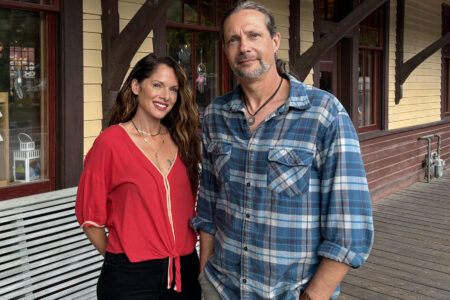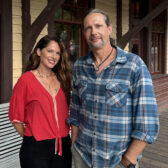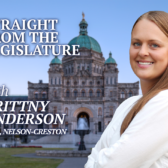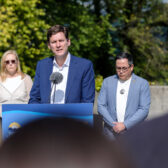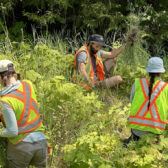Greening Up — Our Children Are Watching Us
“Don’t worry that children never listen to you; worry that they are always watching you.” – Robert Fulghum
In 1790, Irish statesman and philosopher Edmund Burke wrote that society is “a partnership not only between those who are living, but between those who are living, those who are dead, and those who are to be born.”
In 1948, the United Nations ratified the Universal Declaration of Human Rights. Article 6 of the declaration states “Everyone has the right to recognition everywhere as a person before the law” and Article 7 proclaims “All are equal before the law and are entitled without any discrimination to equal protection of the law.”
In 1976, a multilateral treaty adopted by the United Nations General Assembly – the International Covenant on Civil and Political Rights – came into force. Article 6 (1) states “Every human being has the inherent right to life. This right shall be protected by law. No one shall be arbitrarily deprived of his life.”
In 1982, Canada passed the Constitution Act which enshrined the Canadian Charter of Rights and Freedoms where Article 7 says “Everyone has the right to life, liberty and security of the person and the right not to be deprived thereof except in accordance with the principles of fundamental justice.” Article 15 (1) says “Every individual is equal before and under the law and has the right to the equal protection and equal benefit of the law without discrimination and, in particular, without discrimination based on race, national or ethnic origin, colour, religion, sex, age or mental or physical disability.”
In 1990, the United Nations’ Convention on the Rights of the Child came into force. Article 6 (1) states “Parties recognize that every child has the inherent right to life,” and Article 6 (2) states “Parties shall ensure to the maximum extent possible the survival and development of the child.” Article 24 (1) states “Parties recognize the right of the child to the enjoyment of the highest attainable standard of health” and Article 24 (2c) states Parties must take “into consideration the dangers and risks of environmental pollution.”
The above declaration, covenant, and charter agree that every human being has a right to life and equal protection under the law. The Convention on the Rights of the Child stipulates that signatories ensure the development of the child and the right of the child to the highest standard of health.
These are moral codes which guide our actions toward each other as a society. While Edmund Burke said a society included all the living and those not yet born, most democratic states have an age of majority when the young supposedly enter adulthood and can enjoy all the benefits of adults. Most of our laws do not mention future generations.
The construct of an age of majority has defined when children attain certain rights such as when the young can work, drive, consume alcohol, vote, have sex, marry, and make medical decisions.
Children and grandchildren are cherished members of society and are deeply loved, yet the age of majority denies them the ability to engage in civic and political life.
Vivian E. Hamilton, a professor of law at William and Mary School of Law, argues in her 2016 paper Adulthood in Law and Culture that “The age of majority is a construct that has quite lost any social or legal utility it may have once had, and it should thus be abandoned.”
“Climate change is now the biggest health threat to children. These are not children of future generations. These are children living today.” – Sandra Steingraber, author of Raising Elijah: Protecting Our Children in an Age of Environmental Crisis
Climate change has forced us to directly confront the value we put on present and future children but for the most part we have stalled in walking the talk.
In August 2018, at age 15, Swedish schoolgirl Greta Thunberg started spending her Fridays outside the Swedish parliament to call for stronger action on climate change by holding up a sign reading Skolstrejk för klimatet (School strike for climate). Soon, other students engaged in similar protests in their own communities. Together, they organised a school climate strike movement under the name Fridays for Future.
Considering how their lives are currently being affected by climate change and how their futures may be harmed by a warming atmosphere, it is little wonder that children are now standing up and demanding their rights. Despair that adults are not doing enough, fast enough, has driven some youth to take their countries to court.
On October 25, 2019, fifteen Canadian youth from across the country filed a lawsuit against the federal government of Canada for contributing to dangerous climate change and discriminating against youth.
The case, La Rose v. Her Majesty the Queen,is named after Cecilia La Rose, a 15-year-old from Toronto. Her severe asthma is often triggered by air pollution and she has been diagnosed with anxiety, for which she sees a therapist. Her family has experienced heat waves that have shut down her school, and her home has been flooded.
The case argues the youth are already being harmed by climate change and the federal government is violating their rights to life, liberty and security of the person under section 7 of the Charter and for failing to protect essential public trust resources. The youth also allege that their government’s conduct violates their right to equality under section 15 of the Charter, since youth are disproportionately affected by the effects of climate change.
Federal Court Justice Michael D. Manson, despite acknowledging “the negative impact of climate change to the Plaintiffs and all Canadians is significant, both now and looking forward into the future,” rejected their lawsuit in late October, ruling the claims don’t have a reasonable cause of action or prospect of success, so the case cannot proceed to trial. Manson said in his judgement that the network of government actions that contribute to climate change is too broad for the court to grapple with, and the court has no role in reviewing the country’s overall approach to climate change.
“We do not inherit the Earth from our ancestors, we borrow it from our children.” – Native American proverb
On November 26, 2019, seven young people ranging in age from 12 to 24 filed a climate lawsuit against the province of Ontario, claiming that the government’s rollback of climate policies under Ontario Premier Doug Ford violates their fundamental rights.
The youth in the case, Mathur, et al. v. Her Majesty the Queen in Right of Ontario, are represented by lawyers from Ecojustice, a Canadian environmental law charity. The case is named after Sophia Mathur who was the first student to join the Fridays for Future movement, striking for the climate in her home city of Sudbury, Ont. She is the daughter of Cathy Orlando, the founder of the first chapter of the Citizens’ Climate Lobbyin Canada.
Among other things, the plaintiffs want a declaration that Ontario’s target violates the rights of Ontario youth and future generations under sections 7 and 15 of the Charter; a declaration that Ontario’s target violates an unwritten constitutional principle that governments may not engage in conduct that will, or unreasonably could be expected to, result in the future harm, suffering or death of a significant number of its own citizens; a declaration that section 7 of the Charter includes the right to a stable climate system, capable of providing youth and future generations with a sustainable future.
The plaintiffs seek a court order requiring the government to set a science-based emissions reduction target that aligns with the goal of limiting warming to 1.5 degrees Celsius. They claim the government’s failure to act on climate in response to scientific warnings contributes to a dangerous level of climate change that violates their rights under the Canadian Charter of Rights and Freedoms. Specifically, they allege violations of their rights to life, liberty and personal security, as well as violation of the Charter’s equal rights protection
In a landmark decision, Justice Carole J. Brown of the Ontario Court of Appeal said in her judgement “On its face, the Application engages each of the s.7 rights: life, liberty, and security” and ruled the case should go to trial.
In denying Ontario’s motion to strike the youth’s application, Justice Brown ruled the applicants “should be given standing for their generation, as well as for future generations” and said the youth’s case was justiciable and “that the Superior Court of Justice, therefore, is the appropriate venue to hear this Charter-based constitutional challenge.”
Justice Brown wrote in her judgement that the applicants should “be afforded the opportunity to present their complete evidence in front of the application judge, especially in light of the flexible standard used to establish causation in a Section 7 claim.”
Although this is a preliminary action, it is a major breakthrough for Canadian climate litigation. The decision to allow the case to proceed is a first for Canada.
“When silence or tricks of language contribute to maintaining an abuse that must be reformed or a suffering that can be relieved, then there is no other solution but to speak out.” – Albert Camus
Judge Manson stated in his judgement, “Section 7 of the Charter does not instill positive obligations, rather it is premised on the finding of a deprivation resulting from law or state action.”
But like science and most other facets of life, the law is evolving. In 1929, Lord Sankey – England’s reform-minded Lord Chancellor – stated that Canada’s constitution is “a living tree capable of growth and expansion within its natural limits,” a document that is in “a continuous process of evolution.”
In several instances, courts have explicitly left the door open for future Section 7 challenges based on government inaction.
Supreme Court of Canada Chief Justice Beverly J. McLachlin writing in Gosselin v. Quebec (Attorney General), found that “it would be a mistake to regard section 7 as frozen, or its content as having been exhaustively defined in previous cases.”
In other sections of her judgement, McLachlin writes:
- “In certain cases, s. 7can impose on the state a duty to act where it has not done so.”
- “The context in which s. 7is found within the Charter favours a conclusion that it can impose on the state a positive duty to act.”
- “The grammatical structure of s. 7 seems to indicate that it protects two rights: a right, set out in the section’s first clause, to “life, liberty and security of the person”; and a right, set out in the second clause, not to be deprived of life, liberty or security of the person except in accordance with the principles of fundamental justice.”
And Justice Donald J. Rennie, speaking for an unanimous Federal Court of Appeal in Kreishan v Canada stated: “I am cognizant of the fact that Section 7 is not frozen in time, nor is its content exhaustively defined, and that it may, some day, evolve to encompass positive obligations – possibly in the domain of social, economic, health or climate rights.”
Attorneys for the 15 youth plaintiffs in the La Rose v. Her Majesty the Queen case filed their Notice of Appeal with the Federal Court of Appeal on November 24th, alleging Justice Manson erred in striking the plaintiffs’ claims in his October 27th ruling.
The youth in Mathur et al v. Ontario eagerly await their date in Superior Court. In all likelihood it will be heard remotely due to COVID-19.
“There can be no keener revelation of a society’s soul than the way in which it treats its children.” – Nelson Mandela
Climate change requires immediate action, not a promise for action in ten years’ time.
The climate’s enemy is “we” – the “we” who have let our leaders entice us with “I’ll take care of it” promises for more than 30 years.
Multiple generations of children have watched us waver on an issue that is crucial to human survival as a species.
Some adults are now so concerned about global warming they are deciding not to have children, according to a recent academic study.
Today’s children have given up watching and waiting. Their patience has run out. They are demanding the law recognize their right to a future that won’t become a climate catastrophe.
Someday a brave Canadian court will, by enshrining a positive obligation into Section 7 of our Charter, impose a constitutional obligation on government to redress future harm from climate change.
More than 8 million Canadian children are anxiously awaiting that right. For them, it cannot come soon enough.
“The rules of our world are laws, and they can be changed. Laws can restrict or they can enable. What matters is what they serve. Many of the laws in our world serve property – they are based on ownership. But imagine a law that has a higher moral authority… a law that puts people and planet first. Imagine a law that starts from first do no harm, that stops this dangerous game and takes us to a place of safety….” Polly Higgins, 2015
Michael Jessen is a writer residing at Longbeach on Nelson’s North Shore. He is the author of hundreds of articles on sustainability, waste management, climate change and simple living. He can be reached by email at [email protected]
RESOURCES: Unless urgent action is taken now, almost all of the 2.5 billion children living today will live to see a 1.5°C warmer world, more than 90% of today’s 16-year-olds could live to see a 2°C warmer world; 4% will possibly live to see what a 3°C warmer world looks like.
According to Climate Action Tracker, the inadequate emission reductions under current policies will lead to a global temperature increase of more than 3°C by 2100.
Instead of curbing emissions, many of the world’s governments are planning to expand production of fossil fuels like coal, oil, natural gas, and LNG. In order to meet the goals in the 2015 Paris Agreement, fossil fuel production needs to decrease by six percent per year between 2020 and 2030. Countries are currently planning and projecting a two percent increase in fossil fuel production during that time frame.
UNICEF Canada has a web page entitled Climate Change and Children: Taking Action to Save Lives.
In the CBC’s The Nature of Things episode Rebellion six youth who are demanding their right to a future on a liveable planet are profiled.
Climate Analytics published the report Global Climate Change Impacts on Children in September 2019. Report author Inge Menke wrote the blog The Kids Aren’t Alright – Climate Change Impacts On Children Now and In the Future.
The Princeton University-Brookings Institution journal The Future of Children (Vol. 26, No. 1, Spring 2016 issue) was entitled Children and Climate Change.
Robert MacNeil is the author of Thirty Years of Failure: Understanding Canadian Climate Policy.
The Evolution of Canada’s International and Domestic Climate Policy by Silvia Maciunas and Géraud de Lassus Saint-Geniès can be downloaded at https://www.cigionline.org/publications/evolution-canadas-international-and-domestic-climate-policy-divergence-consistency.
Sheridan Bartlett, a research associate at the City University of New York, wrote the paper Climate Change and Urban Children: Impacts and Implications for Adaptation in Low- and Middle-Income Countries.
The Canadian Paediatric Society posted the position paper Global Climate Change and Health in Canadian Children in August 2019.
Jedediah Britton-Purdy, a law professor at Columbia Law School, writes about becoming a late-in-life parent in The Atlantic article The Concession to Climate Change I Will Not Make.
The following is a record of the commitments made by Canada’s Prime Ministers about reducing the country’s greenhouse gas emissions. Canada has set multiple goals for curbing emissions over the last three decades and has never met a single one of them.
Between 1990 and 2018, Canada’s GHG emissions have increased 20.9 percent. Canada ranked as the 11th largest global emitter of greenhouse gases in 2018.
Brian Mulroney (September 1984 to June 1993) – Mulroney hosted the World Conference on the Changing Atmosphere in 1988, one of the first major international conferences on the issue of climate change. The conference adopted a CO2 emissions-reduction objective of approximately 20 percent below 1988 levels by 2005. The Mulroney government’s Green Plan of 1990 pledged to stabilize Canadian GHG emissions at 1990 levels by the year 2000.
Kim Campbell (June 1993 to November 1993) – Campbell was only in office for 132 days. She is now a member of the Global Leadership for Climate Action, part of the Bill Clinton Global Initiative. She criticized Conservative Leader Andrew Scheer’s climate policy during the 2020 election campaign. “They produced a plan that has no targets,” she said in a CBC interview. “It really is a sop, I think.”
Jean Chretien (November 1993 to December 2003) – The 1993 Liberal election campaign pledged to reduce GHG emissions 20 percent below 1990 levels within a decade. In 1997, during the Kyoto Protocol negotiations, Canada committed to legally binding GHG emissions reduction target of six percent below the 1990 levels by 2012. Earlier in 1997, Chretien had convinced the provinces to agree to stabilize GHG emissions at 1990 levels by 2010. According to Environment Canada, the country’s emissions were 13.4 percent above 1990 levels in 1997. Chretien ratified the Kyoto Protocol in 2002 in the face of provincial opposition and in spite of the absence of the United States from the agreement.
Paul Martin (December 2003 to February 2006) – Martin tended to speak only in generalities about his views on climate change although at COP 12 in Montreal he suggested the United States lacked a global conscience for abandoning the Kyoto Protocol. He wanted to establish a national cap-and-trade scheme using the regulatory authority of the Environmental Protection Act to regulate “harmful” substances like GHGs. When Martin lost the 2006 election, not only had Canada’s emissions not declined by the promised 6 percent below 1990 levels, they had increased by roughly 27 percent.
Stephen Harper (February 2006 to November 2015) – Harper’s government introduced a plan in 2007 to regulate greenhouse gas emissions and air pollutants from industrial emitters. The plan hoped to achieve the government’s national target of an absolute reduction in Canada’s total greenhouse gas emissions by 20 percent from 2006 levels by 2020 and reductions of 60 to 70 percent below 2006 levels by 2050. In 2010, Canada said it wanted to be part of the 2009 Copenhagen Accord and pledged to reduce its emissions by 17 percent below 2005 levels in harmony with U.S. commitments. Harper withdrew Canada from the Kyoto Protocol in December 2011, making Canada the only country in the world to withdraw from the treaty after having ratified it. Canada was dishonoured with an inauspicious ‘Lifetime Unachievement’ Fossil award in November 2013 during the final official day of the UN climate negotiations. Granted as part of the long-running satirical Fossil of the Day / Fossil of the Year awards series, the special prize was given to point out the Harper government’s longstanding failure to make meaningful contributions and instead resort to blocking and stalling progress at the UN climate talks. In May 2015, the Harper government committed to reducing greenhouse gas emissions by 30 per cent below 2005 levels by 2030.
Justin Trudeau (November 2015 to present) – Trudeau’s government passed the Pan-Canadian Framework on Clean Growth and Climate Change in 2016 to put Canada on a path towards meeting its Paris Agreement GHG emissions reduction target of 30 percent below 2005 levels by 2030. Despite professed concerns about a warming climate, Trudeau purchased the Trans Mountain pipeline and continues with its expansion plan. He has also supported proposed LNG exports from British Columbia. Experts say TMX and LNG extraction and export will make it impossible for Canada to reach its climate goals. Bill C-12 introduced November 19th would legally bind the government to set multiple targets to reduce greenhouse gas emissions over the next 30 years. The legislation, if passed, would require the federal environment minister to set five-year targets for cutting carbon emissions starting in 2030, and ending in 2050, when Canada is supposed to hit net-zero. Just prior to the Climate Ambition Summit in Bristol, England on December 12th, Trudeau pledged $15 billion in initiatives to combat climate change and put Canada on track to cut greenhouse-gas emissions by as much as 40 percent below 2005 levels by the end of this decade, versus the current 30 percent goal.
“Global warming threatens the survival of our species. We have to act now or we’re in deep trouble.” – Lucien Bouchard, Minister of Environment in the Mulroney cabinet, 1988



